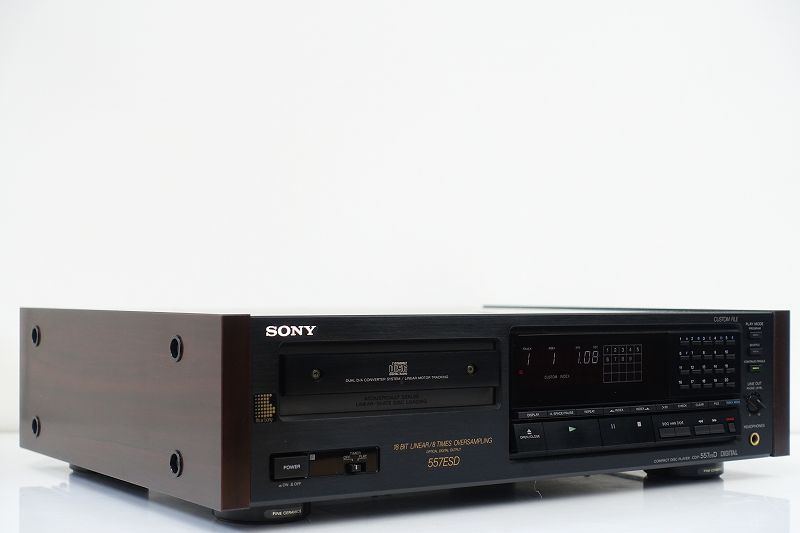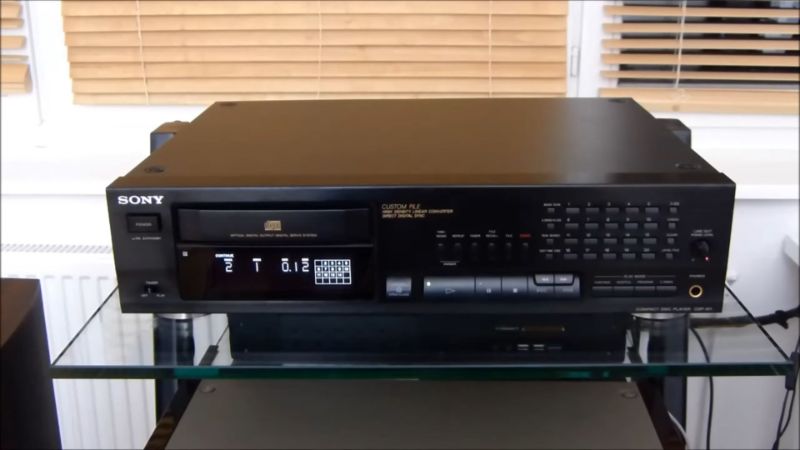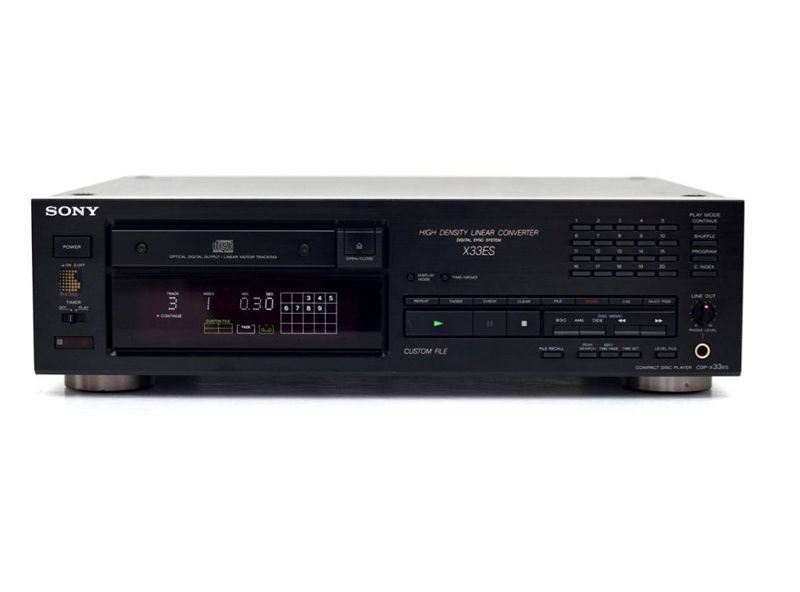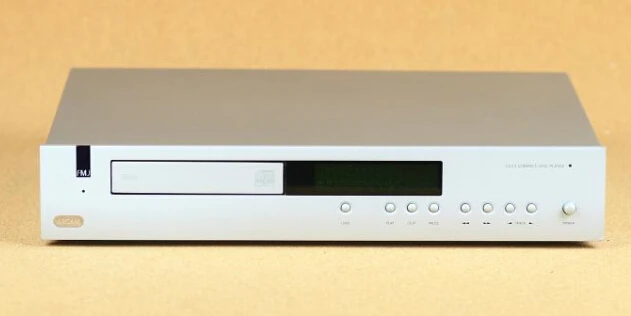The SA-1 from Marantz was the state-of-the-art in high-resolution digital audio thinking in 2001. Compact Disc had been around for about two decades, during which time it had been polished and streamlined to the point that it could no longer function. Thanks to the redoubtable talents of its technical figurehead Ken Ishiwata, Marantz had shown particularly competent at squeezing a quart out of CD’s metaphorical pint pot. But then he moved on to something far bigger and better: the Super Audio Compact Disc…
Three years prior, SACD was announced. It had a number of theoretical advantages over Pulse Code Modulated CD and DVD audio formats, not least of which was its very wide frequency range without the need for drastic high band filtering. It used single sided, dual layer discs with Sony’s proprietary Direct Stream Digital coding technology. With a sampling rate of 2.8224MHz, it has a potential frequency response of DC to over 100kHz and a dynamic range of more than 120dB.
Sony developed Direct Stream Digital, a kind of Bitstream coding, in the early 1990s to transition its CBS music division’s ageing analogue master tape stock into the digital domain. Sony claimed that employing PCM ADCs was an overly complex and lossy procedure that involved converting analogue to bitstream digital, bitstream to CD’s 16-bit PCM, then PCM back to bitstream for contemporary CD players’ one-bit DACs. Why not keep the bitstream of the numbers all the way down the chain? It was easier to convert to and from PCM, and it was less likely to lose data.
Unlike PCM, DSD sets both resolution and bandwidth based on the sampling frequency. At a master clock frequency of 44.1kHz, a one-bit word is oversampled 64 times, resulting in a sampling frequency of 2.8224MHz. When compared to DVD-192kHz Audio’s PCM, this appears to be astronomical, however comparisons are misleading due to the different word lengths. DSD’s 64 times oversampling can provide four times the bandwidth of CD while maintaining the same Signal to Noise ratio, or four times the S/N while maintaining the same bandwidth, however Sony chose 120dB S/N and a 100kHz bandwidth.
DSD has a number of advantages in addition to its simplicity. One difference is that, unlike PCM, it has a wide 100kHz bandwidth with no dramatic brickwall filter at the top of the frequency range. This implies that rather than being severed off at one random time, the harmonics in the song are permitted to softly fade away on their own. DSD’s 2.8224MHz sampling frequency is a multiple of the current 44.1kHz standard, making it ideal for ‘down conversion’ into other formats like Redbook CD or MiniDisc. Rather than requiring interpolation (or “guesstimation”) to reduce 96kHz PCM data to 44.1kHz, DSD may be converted quickly. The DSD coding scheme was first commercially implemented on a disc with Super Audio Compact Disc.
The SA-1 was Marantz’s initial no-expense-spared attempt to squeeze the most out of the new format, and it’s still a pretty spectacular beast by today’s standards. This slickly polished front loader weighs over 20kg and features machined aluminum-alloy casings painted in the company’s distinctive champagne gold. The fascia is dominated by large Play, Stop, and Pause buttons, with smaller switches for SACD/CD and Display on/off, Open/Close, and Track Advance/Back.
Two single-ended RCA phono jacks, a pair of balanced XLRs, TOSLINK and coaxial digital outputs (only for use when playing standard Red Book CDs), an IEC mains plug, and a ‘Standard/Custom’ Filter switch are all found on the back panel (a la Sony SCD-1). The ‘Standard’ setting reduces the SA-1’s extremely high frequency output, which is enabled by selecting the ‘Custom’ setting. Marantz recommends the former for general use because the latter can cause problems with some partnered amplifiers and loudspeakers.
We find a delicious feast of digital audio treasures inside the beast. Internal resonance dampening and electrical noise isolation are the goals of the chassis’ construction. A copper-plated double-layer steel bottom plate and shock-absorbent mounting feet are included, as is a massive shielded toroidal transformer with ‘Super Core Ring’ technology, which is encased in a cylindrical copper cage. A second, smaller transformer is used to power the fluorescent display. The transport features a diecast aluminium disc tray with zinc pieces, as is customary in Japanese high-end vehicles. Both CD (and CD-R/CD-RW) and SACD are read by the dual lens pickup mechanism. There are four TDA1547 1-bit Dual Bitstream DACs (two per channel) in the digital audio portion, and six dual Marantz HDAM (High Definition Amplifier Modules) op-amps in differential format, plus two in the unbalanced output.
This player sounds fantastic even with normal 16/44 CDs. It’s a riot tonally. Its low-frequency power is as if it were connected to Mother Nature herself, its midband is as clear as love poetry, and its treble response is good enough to bring the bats out of the trees to sing. It doesn’t rosy color whatever it plays, unlike Marantz’s previous ultimate silver disc spinner, the CD-17. This means that if a piano or a human voice is badly recorded, it will tell you about it rather than ignoring it. As a result, it’s a transparent player with a large and varied palette of tone colors that it uses without hesitation.
So it’s one of those sleazy high-end CD players that makes you think you’re listening to a half-decent turntable? Wrong, because the SA-1 matches the likes of Naim’s CDX in terms of rhythms, dynamics, and transient assault – which is no small feat. To this Marantz, leading edges are meat and drink – with a natural proclivity for starting and stopping on a sixpence, music simply sounds faster. When you combine this with its ability to create subtle dynamic inflections – another Naim-like quality – it’s no surprise that it can keep up with Escape That’s complicated drum patterns with ease.
Information retrieval is equally enthralling. Tomorrow’s Girls by Donald Fagen is taken from the oddly mixed Kamakiriad album. Because most CD players transform it into a splashy mess, it’s a wonderful torture track. The Marantz, on the other hand, sped through like it was on vacation, digging up massive amounts of low level like there was no tomorrow. Fagen’s voice took on a new dimension, guitar licks decayed gradually, and there was even a hint of timbral texture to enjoy.
The SA-1 stayed admirably consistent across my whole CD library. It’s as transparent and open as the CD format allows. You couldn’t call it “glass clear” because old sixteen bit doesn’t have it on the menu, but it’s about as good as you’ll get. I’ve rarely heard such an addicting blend of musicianship, tone correctness, and pure hairy-chested, muscular grunt. Was it, as some have claimed, the finest CD player in the world at the time? No. I’m not sure I’d go that far, but it’s a unique experience.
The SA-1 from Marantz was undoubtedly what the hi-fi world had been waiting for with SACD. Even in 1982, Marvin Gaye’s Midnight Love – hardly a cutting-edge recording – was a delight. You know you’re listening to something exceptional from the first beats of that terrible ‘period’ Roland drum machine on Sexual Healing. Instead of being just another generic drum machine, you get something that sounds like a ‘Speak and Spell’ toy, which is exactly how those early Dr. Rhythms did! Then, in a matter of seconds, one of the sweetest, smoothest, silkiest voices ever recorded on magnetic tape enters. The contrast between the song’s gravel-like electronic percussion and the singer’s creamy gloss is totally stunning, and something you won’t hear unless you’re listening to high-end vinyl.
Marvin’s voice is surrounded by an unbelievable amount of space. You start to realize how beautifully vivid this new format can be as it hangs out of the speakers yet is unexpectedly far back in the mix — those drum rhythms are banging away aggressively in front. It simply brings you closer to the music by combining tremendous rhythmic snap – everything about its sixteen bit performance holds true for SACD, and then some – with a deliciously organic character.
Even in that rude artificial percussion, you can discern subtle dynamic inflections that a sixteen bit CD entirely misses. It’s as though the drum programming has been completely redone, with the producer keeping the rhythms but shifting the accents. Something that previously sounded like it was played on a Casio calculator has now sprung to life! SACD is brimming with surprises and delights. It’s a great feast for the senses, whether it’s hearing guitar strings decay for bar after bar rather than simply fading into the electronic ether, or revelling in the delightfully rich and full bass guitar sound.
When you turn up the volume on a well-recorded DSD track like Jacintha’s One for My Baby, the SA-1 really shines. The best way to put it is as follows: Which format would you prefer to spin your prized jazz albums on at the end of the day, when you’ve got a drink in one hand and a cigarette in the other? I wouldn’t have given it a second thought before putting the vinyl away. SACD, on the other hand, is now a close second, even if it doesn’t quite win the day. I’ve rarely heard a drum kit, electric guitar, piano, and double bass sound so hauntingly, spookily life-like, with a noise level that goes down to your listening room’s very foundations.
The reproduction of female vocals was where Compact Discs failed the most miserably. Its coding spec was just too ragged in the sensitive upper midrange region into which these fall, and the result is a dulling and coarsening of what can be one of the world’s great wonders – in some cases, at least. The 2001 Marantz SA-1, on the other hand, offered new levels of transparency and nuance to silver disc, opening the music up and letting you in in a manner that digital had never done before.






